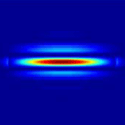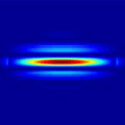A light-matter laser squeezed into a nanowire
Before a typical laser can shine, a minimum (threshold) amount of energy needs to be pumped into an optical amplifying medium to create a so-called population inversion of the light emitters. Now, a paper appearing in Physical Review Letters shows this threshold energy for polariton lasers, a new type of semiconductor laser, could be significantly reduced if the laser is fashioned from a nanowire.
Polaritons are light-matter hybrids. These particles form when light, confined to a cavity, couples strongly to an excited electron-hole pair (exciton) within the cavity. Unlike conventional lasers, polariton lasers don’t require a population inversion and stimulated emission. Instead, a quantum coherent state of exciton-polaritons, which are bosons, is generated by stimulated polariton-polariton scattering. This polariton state generates coherent light when the excitons spontaneously recombine. Thus, in a conventional laser the emission is stimulated, while in a polariton laser it is the scattering that is stimulated.
Low-threshold polariton lasers that work at room temperature have been made from bulk gallium-nitride ( ) sandwiched between two semiconductor mirrors. In their new work, Ayan Das and his colleagues at the University of Michigan in Ann Arbor were able to significantly reduce the threshold energy of such lasers by replacing the bulk with a nanowire, nanometers ( ) in diameter and long. The improvement occurs because nanowires can be prepared with few defects and a uniform distribution of gallium and nitrogen, while the geometry of the wire ensures a strong interaction between the light and the excitons. – Jessica Thomas





